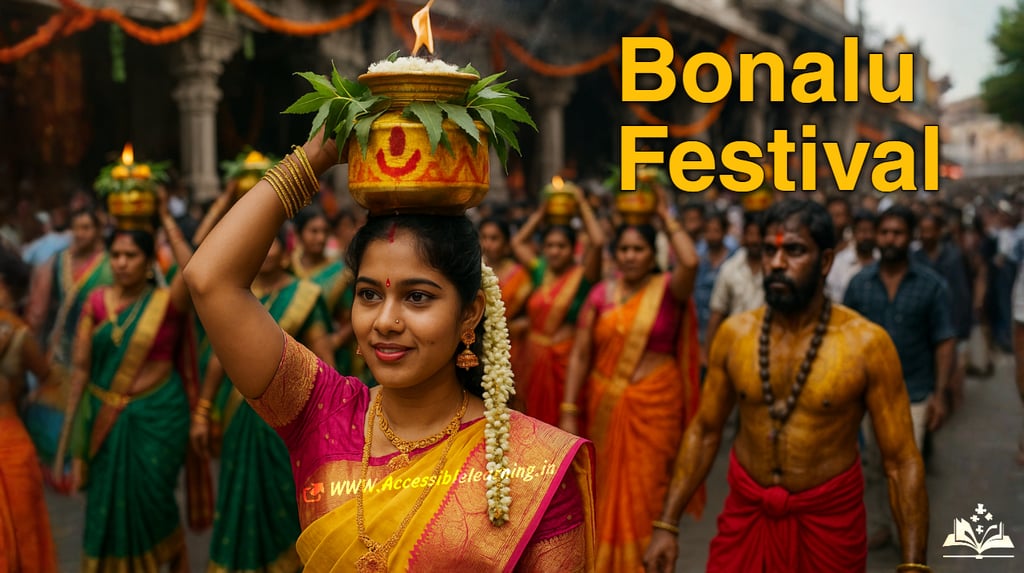
Bonalu Festival – A Vibrant Tribute to the Goddess Mahakali in Telangana
Discover the vibrant Bonalu Festival of Telangana, a spiritual tribute to Goddess Mahakali. Explore its rituals, history, cultural significance, symbolic offerings, folk art, and modern-day celebrations in Hyderabad and beyond.
CULTURE/TRADITIONEVENT/SPECIALINDIA/BHARATCELEBRATION/FESTIVALS
Keshav Jha
7/14/20255 min read


Bonalu is a traditional Hindu festival celebrated with immense fervor in the Indian state of Telangana, especially in Hyderabad, Secunderabad, and other parts of the state. This month-long celebration is dedicated to Goddess Mahakali and is observed during the Ashada Masam (June-July) of the Hindu calendar. The word Bonalu comes from the Telugu word “Bhojanalu,” meaning meals or feast—a reference to the food offerings made to the Goddess.
Bonalu is not just a religious ritual—it is a cultural expression, a community event, and a celebration of female power and divine protection. The festival reflects the spiritual depth, folklore traditions, and vibrant cultural identity of Telangana.
Origin & Historical Significance
The roots of Bonalu trace back to the 18th century, when Hyderabad and surrounding regions were struck by a devastating plague. It is believed that a military battalion deployed in Ujjain prayed to Maa Mahakali for protection. After the epidemic ended, as a token of gratitude, they brought back a special idol of the Goddess to Secunderabad and started the tradition of Bonalu.
Thus, Bonalu became an annual thanksgiving festival where people express their gratitude and seek blessings for health, prosperity, and protection from evil forces.
Rituals & Offerings
Bonam (The Sacred Offering)
The central ritual of the festival involves women preparing rice cooked with milk and jaggery in a new brass or earthen pot. The pot is decorated with neem leaves, turmeric, and vermilion and covered with a lit camphor lamp.
These pots—Bonam—are carried on the heads of women and girls in processions to local temples, especially those dedicated to Mahakali.
Pothuraju—The Festival’s Fierce Protector
Pothuraju is a significant character in the Bonalu festival—considered the brother of the Goddess, he dances with fierce energy to ward off evil spirits. He wears a red dhoti, turmeric on his body, bells around his waist, and whips in hand, performing wild dances in temple processions.
Animal Sacrifices & Offerings
As a part of certain traditional rituals, animal sacrifices like goats or chickens are made in some temples. Alongside Bonam, people offer coconuts, bangles, sarees, turmeric, vermilion, and other feminine gifts to the deity.
Key Temples & Celebrations
The celebrations peak at specific temples each week, making Bonalu a month-long mobile festival.
Sri Ujjaini Mahakali Temple (Secunderabad)—This is where the modern Bonalu tradition is believed to have originated.
Lal Darwaza Mahankali Temple (Old City, Hyderabad)—A central site for the final and grand celebrations.
Akkanna Madanna Temple (Shah Ali Banda)
Muthyala Temple and Balkampet Yellamma Temple—Also witness massive participation.
The third Sunday of Ashada Masam is considered the most auspicious and witnesses the grand finale of the festival.
Dance, Music & Community Celebrations
Bonalu is not just about rituals but also a colorful cultural experience.
Traditional folk dances, including the Oggu Katha, dappu beats, and bonalu songs, create a charged, festive atmosphere.
Women in traditional attire (sarees with flowers and bangles) and men in dhotis and headbands participate in group processions, accompanied by drumbeats and chants of "Jai Mahakali!"
Streets and temples are decorated with flowers, lights, and rangolis.
Spiritual & Cultural Significance
Empowerment of Women: The festival highlights the role of women as divine carriers of strength and sustenance, symbolizing Shakti (power).
Community Unity: Bonalu brings together people from different backgrounds, showcasing a deep sense of community bonding.
Devotion and Gratitude: It is an opportunity for devotees to express thanks for divine protection and to seek blessings for future well-being.
2025 Bonalu Dates & Schedule (Expected)
Starts: Sunday, July 6, 2025
Ends: Sunday, July 27, 2025
Main Events:
Ujjaini Mahakali Bonalu: July 13
Lal Darwaza Bonalu (Grand Finale): July 27
(Note: Dates may vary slightly depending on temple traditions.)
Government Involvement & Public Holiday
The Telangana government officially declares a state holiday for Bonalu. Cultural programs, bonalu exhibitions, and government-sponsored processions are part of the celebrations. Authorities ensure proper arrangements for crowd management, temple security, and amenities for devotees.
Interesting Facts About Bonalu
The female devotee carrying the Bonam is considered a temporary incarnation of the goddess, and people touch her feet in reverence.
The festival is included in Telangana’s Intangible Cultural Heritage list and has been promoted as a state festival since 2014.
Bonalu is closely linked with Telangana identity, often celebrated alongside Bathukamma in the state’s cultural narrative.

Deeper Mythological Significance
While the primary association is with Maa Mahakali, Bonalu also honors her regional manifestations, such as:
Peddamma (The Supreme Mother)
Yellamma (Goddess of the Poor and Downtrodden)
Dokkalamma, Ankalamma, Maremma, Poleramma, and Nookalamma
These are considered grama devatas (village deities) in South Indian folk belief. Bonalu, therefore, is not just about a singular deity but represents a pantheon of powerful local goddesses.
This reflects the pre-Vedic matriarchal traditions in South India, where nature and feminine power were worshipped long before classical Hinduism took root.
Role of Folk Art & Oral Traditions
Bonalu is a living performance of folk arts, storytelling, and community theater. These include:
Oggu Katha—A dramatic musical narration that tells stories of gods and goddesses through rhythm and dialogue.
Perini Shivatandavam—Though a masculine dance form, it is sometimes performed during Bonalu rituals to symbolize divine fury and energy.
Golla Suddulu and Haridasu—These wandering minstrels are seen singing devotional songs in local dialects during the month of Bonalu.
These performances help preserve Telangana’s oral history, ensuring the tales and traditions are passed from generation to generation.
Symbolism in Ritual Objects
Every object used in Bonalu has deep symbolic significance:
Neem leaves: Known for their antiseptic and purifying properties, they are used to ward off evil energies and diseases.
Camphor flame: Represents divine light, clarity, and transformation.
Bonam pot: Symbolizes the womb—life, nourishment, and devotion.
Red and turmeric colors: Red (kumkum) for Shakti (energy), and turmeric for purity and auspiciousness.
These elements also reflect Ayurvedic principles, blending spiritual and medicinal knowledge.
Psychological & Societal Relevance
Bonalu is an outlet for collective catharsis and healing. The dances of Pothuraju, trances of devotees, and intense drumming induce an altered state of consciousness. This serves several purposes:
Cleansing trauma and fears (especially post-pandemic or epidemics)
Community resilience building
Offering people a channel to express grief, gratitude, and divine connection
In modern psychological terms, it can be seen as a form of ritual therapy or emotional detoxification.
Environmental & Seasonal Context
The festival is rooted in the Ashada Masam, which coincides with the early monsoon season. This timing is no accident:
Monsoon diseases were historically common—Bonalu offered a ritualistic way to invoke protection.
The cooking of rice with jaggery and milk is not just an offering—it’s seasonally suitable, easy to digest, and energetically cooling during humid weather.
Neem is also abundant in this season and used extensively for its medicinal properties.
Women’s Leadership & Representation
Unlike many patriarchal temple traditions, Bonalu is woman-centered:
Women lead the rituals, carry the Bonam, and are treated as living vessels of the goddess.
The processions are female-dominated—symbolizing matriarchal power and fertility.
Even transgender women (Hijras) participate in many regions, offering Bonam and receiving special attention—showcasing inclusivity in devotion.
Bonalu & Urban Culture
In contemporary times, Bonalu has evolved with urban life:
Corporate sponsors and tech companies in Hyderabad often organize Bonalu-themed events and awareness campaigns.
Street food, artisan stalls, and handicraft markets around temples have made Bonalu a source of economic livelihood for many.
Social media has transformed the way Bonalu is shared—reels, influencer coverage, and livestreamed processions are now common.
Lesser-Known Facts
Bonalu in Mahabubnagar is performed by tribal communities with unique rituals not found in urban Hyderabad.
The festival is sometimes referred to as “Ashada Jatara” in remote districts.
In certain villages, mask dances (veeranatyam) are performed, where men wear grotesque masks and dance as fierce spirits.
Some women devotees enter trance-like states and are believed to channel the goddess, speaking divine messages or blessings.
Bonalu is a soulful tribute to feminine divinity and a resounding echo of Telangana’s cultural pride. It’s a living tradition that connects the past to the present—through devotion, music, dance, rituals, and the enduring belief in the protective power of Maa Mahakali. As Telangana shines on the map of India's cultural festivals, Bonalu remains its fiery, festive heartbeat.
Subscribe To Our Newsletter
All © Copyright reserved by Accessible-Learning Hub
| Terms & Conditions
Knowledge is power. Learn with Us. 📚


